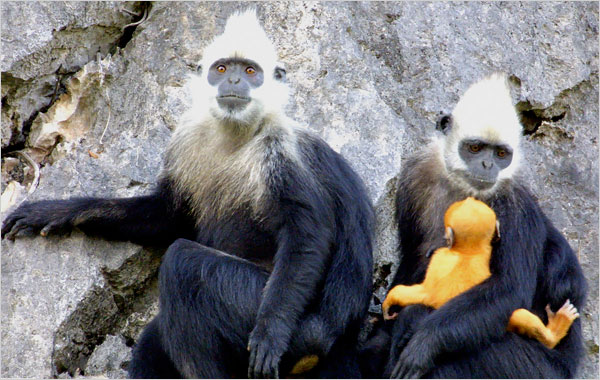The science section can be a pleasant diversion from the overheated controversies on the front page of the newspaper, but this week there is a connection that shouldn’t be overlooked. Let’s start with the science.
This is a portrait of three langurs, an endangered species residing in southern China. Between hunting and deforestation, they were on a steep slope toward extinction. This population was down to 96 when Chinese biologist Pan Wenshi began studying them in 1996. Today, despite continued development in the area, they number around 500.
The picture above may look like a nuclear family but actually is a mother, child, and another female. Monkeys have social organization, one might even say polity, to survive, and this population may even be experiencing socio-political evolution from patrilineal infantide to negotiated power sharing. What is equally impressive is how Dr. Pan called on human social organization to develop a more effective strategy for saving the langurs. Instead of enclaving the endanged population and focusing all his resources on them, Pan worked at improving the infrastructure for the human population surrounding them. Soon the villagers had clean water, medical services, a school, and more sustainable energy–basic infrastructual needs that required only smart designs, effective advocacy, and not a great deal of money. One result was that the forests recovered and villagers started to protect the monkeys from hunting.
So why am I telling you this? Because in the front section of the newspaper you can read all about the $700 billion bailout plan for reckless financial corporations that is being pushed by the Bush administration. That’s the same administration that refused to regulate the industry or address any of the danger signs that have been accumulating for several years. I’ll let that go, because now the key question is how to protect the economy. And that’s why we need to pay attention to Dr. Pan instead of Treasury Secretary M. Paulson Jr. and company.
The gist of the administration proposal is that we have to save the few in order to save the many. The few don’t deserve to be saved, that that’s not important; they are likely to salvage enormous personal fortunes despite financial malpractice, but that’s a separate issue; there are no obligations in place of continuing incentives for mismanagement, but this is not the time for that; the costs are excessive and are to be paid by millions of people who have done no wrong and will be harmed by the payout, but we don’t have time to do anything else; this is contrary to the reigning ideology that is one cause of the disaster, but we must be practical rather than principled or “partisan.” Or so we are told.
I’d like to think that this debacle is one of the last vestiges of the political economy of twentieth century oligarchy. That’s too optimistic, of course, but it does suggest that the complex problems of the twenty-first century require smarter, less resource-intensive, and–let’s say it–more democratic solutions. The approach taken by Dr. Pan, for example. His basic idea is that in order to save the few, you have to save the many.
There has been a lot of talk about prudence lately in respect to both Wall Street and the presidential campaign. The administration’s bailout is not prudent. In the name of saving the system it puts system sustainability at risk. While claiming that the issue is of the highest seriousness, it refuses to take the time for adequate deliberation. Instead of concentrating on foundational issues such as a fair distribution of wealth, maintaining essential infrastructure, providing adequate regulation for a modern economy, and otherwise protecting the basic social contract that undergirds the society, it ransoms all that for a quick fix.
The plan may go through. A similar propaganda campaign led to another trillion dollar disaster not too long ago, so the cynical money may be on Paulson. Whatever happens, the rest of us need to start emulating Dr. Pan’s approach. He had specific advantages that favored its development, of course: he was far from the center of power, had little money, and cared about more than his own self-interest. Come to think of it, we may have a lot in common.
Photograph by Peking University Chongzuo Biodiversity Research Institute. The accompanying story is here.

[…] this latest “financial crisis” there have been some fascinating images which communicate possible alternative narratives to the daily press stories. The image above from […]
[…] this latest “financial crisis” there have been some fascinating images which communicate possible alternative narratives to the daily press stories. The image above from […]